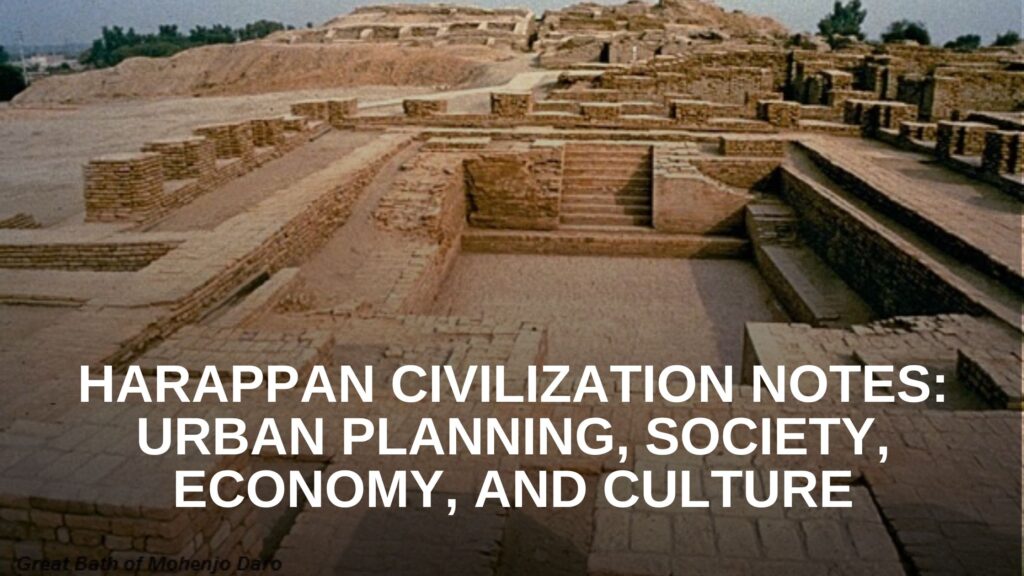The Harappan civilization, one of the most advanced ancient societies, is renowned for its remarkable urban planning. The well-structured cities, fortified settlements, and efficient drainage systems reflect a level of organization far ahead of their time.
Harappan Civilization
Town Planning
Harappan cities were meticulously planned, with the entire town divided into two sections: the Citadel and the Lower Town. The Citadel was an elevated area, likely housing the ruling class, priests, and wealthy merchants. I
n contrast, the Lower Town accommodated the common people. Both sections were constructed on raised platforms and fortified with burnt brick walls, ensuring protection from floods and external threats.
Roads and Housing
The roads of Harappan cities followed a grid pattern, intersecting at right angles. These wide roads had streetlights at crossings and well-maintained drainage systems. Houses were built alongside roads in a uniform manner, using burnt bricks in a standardized ratio of 4:2:1 (Length: Width: Height).
Each house featured multiple rooms, including a drawing room, bedroom, kitchen, veranda, bathroom, and a nearby well. Small windows and high compound walls ensured privacy and security. Evidence suggests the presence of multi-storied buildings, indicating advanced construction techniques.
Read our Previous Blog.. Indus Valley Civilization Notes
Drainage System
Harappan cities had one of the world’s earliest and most sophisticated drainage systems. Each house had drains leading to larger street drains, which were covered with burnt bricks and had inspection holes for maintenance. These drains eventually emptied into large wells outside the city, ensuring a clean and hygienic environment.
Granaries and Storage
The Harappans constructed massive brick granaries on raised platforms to store surplus grain and prevent flooding. The granaries, often the largest structures in the city, were designed with separate compartments for efficient storage.
Cities like Harappa, Mohenjodaro, and Lothal had extensive granaries, complete with platforms for threshing crops and rooms for laborers.

Social Structure
Despite their highly organized urban life, Harappans did not exhibit signs of dynastic rule or absolute monarchy. Instead, their society appeared to function under an oligarchic system, with rulers, merchants, and priests forming the upper class. The presence of joint family households and varying construction styles also hint at social stratification.
Harappan artifacts suggest a high degree of standardization, evident in their seals, weights, and tools, indicating a centrally regulated economy. Burial patterns also reflect social differences, with some graves containing luxury items while others were simpler.
Religion and Beliefs
Unlike contemporary civilizations such as Egypt and Mesopotamia, Harappans did not construct grand temples. However, religious symbols like the Pashupati seal, Mother Goddess figurines, and fire altars suggest spiritual practices. The Proto-Shiva theory, based on a seal depicting a horned deity surrounded by animals, suggests an early form of Shiva worship.
Other religious elements include phallus worship, fire rituals, and reverence for the pipal tree. Burial practices varied across sites. While Mohenjodaro had burials within the city, other sites like Harappa, Lothal, and Dholavira had designated cemeteries. Some graves contained valuable items, indicating a belief in the afterlife.
Art and Craftsmanship
Harappan artisans excelled in sculpting, pottery, and bead-making. Their famous seals, primarily made from steatite, featured intricate animal motifs and an undeciphered script. These seals were used for trade, identification, and possibly amulets.
Notable sculptures include:
- Dancing Girl (Mohenjodaro) – A bronze statue made using the lost wax technique, depicting a young woman in a lively posture.
- Bearded Priest King (Mohenjodaro) – A steatite sculpture with a shawl draped over one shoulder.
- Male Torso (Harappa) – A red sandstone sculpture showing advanced craftsmanship.
Pottery was another significant art form, with plain, painted, and perforated varieties. Bead-making factories at Chanhudaro and Lothal produced exquisite beads from materials like carnelian and steatite.
Read more…Chalcolithic Age UPSC Notes
Economy and Trade
Harappan economy thrived on agriculture, craftsmanship, and trade. They cultivated wheat, barley, peas, and rice, and domesticated cattle, sheep, and goats. Tools like terracotta ploughs and copper sickles suggest advanced farming techniques.
Trade played a crucial role in their economy. Harappans traded extensively with Mesopotamia, exchanging goods like copper, beads, ivory, and textiles. Archaeological evidence suggests links with regions like Oman, Afghanistan, and South India. Boats and carts were used for transportation, further facilitating trade.
Script and Language
Harappans developed a pictographic script, primarily found on seals. Though undeciphered, these inscriptions suggest a written language. The script was written from right to left and featured around 400 distinct symbols.


